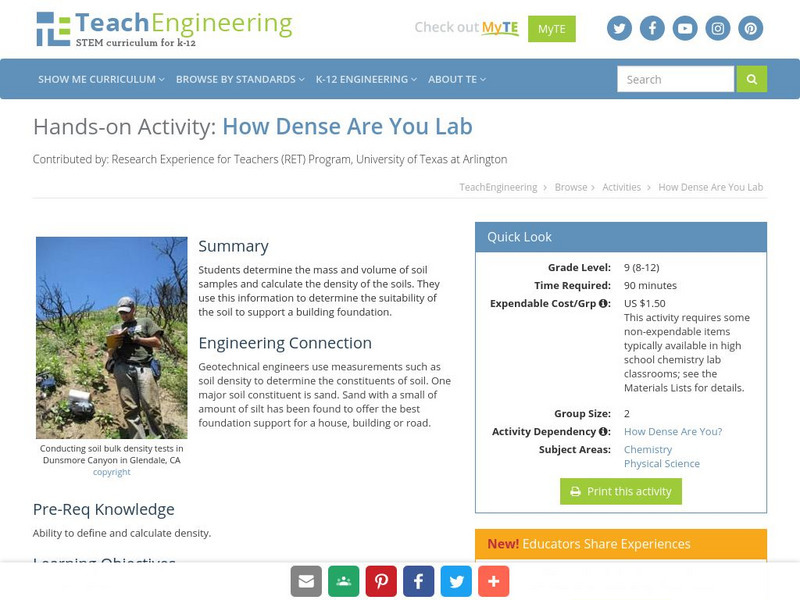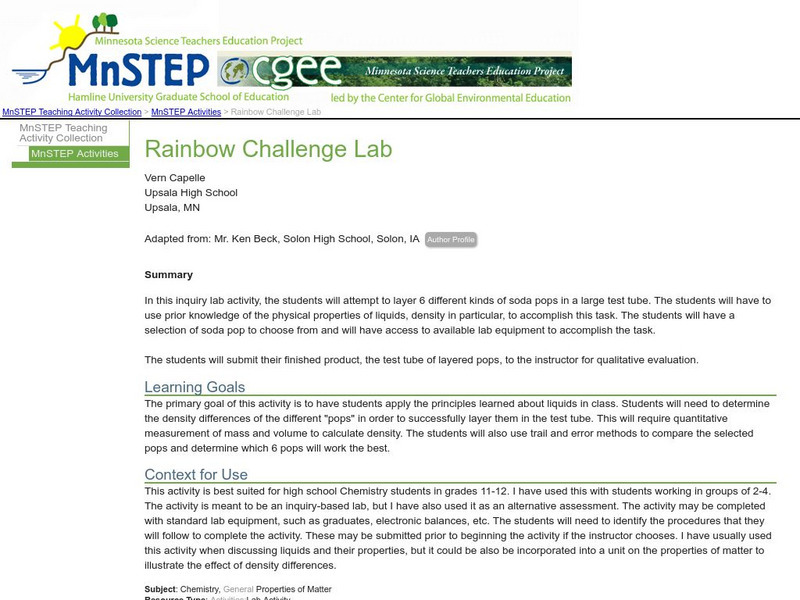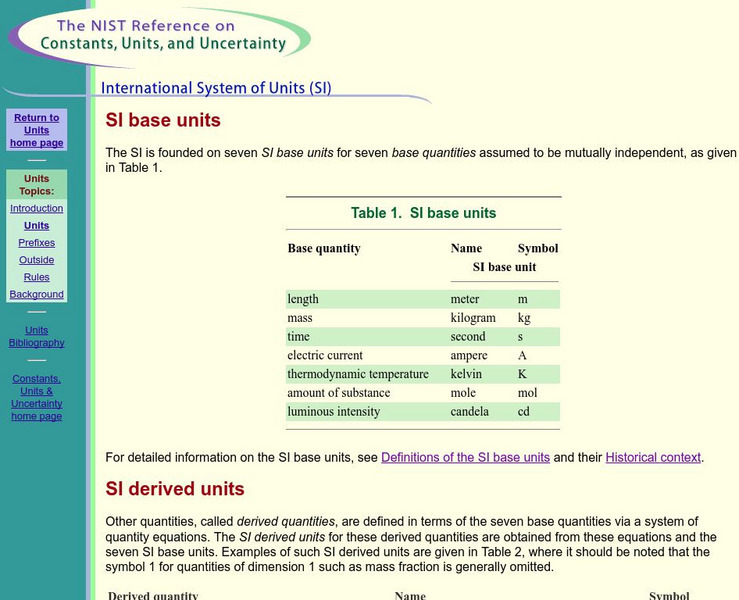Hi, what do you want to do?
Alabama Learning Exchange
Alex: Density
Density is the ratio of mass to volume. Density will be introduced to students by a demonstration of coke verses diet coke. The teacher will then solve density problems for the students on the board. The class will then complete a lab on...
TeachEngineering
Teach Engineering: How Dense Are You Lab
Students determine the mass and volume of soil samples and calculate the density of the soils. They use this information to determine the suitability of the soil to support a building foundation.
Chem4kids
Chem4 Kids: Symbols in Chemical Equations
Chem4Kids! provides an overview of the symbols representing numerical values in chemical equations. Each symbol is defined and described.
TeachEngineering
Teach Engineering: The Physics of Fluid Mechanics
Five lessons about the study of fluid mechanics. The unit concludes with students applying what they have learned to determine the stability of individual above-ground storage tanks given specific storm conditions so they can analyze...
PBS
Pbs Learning Media: Matter's Physical Properties: Interactive Lesson
In this interactive lesson, learn what the "physical properties" of matter are and how can they be measured and observed.
Alabama Learning Exchange
Alex: Float or Sink?
Students will define density and use the density formula to determine the density, volume, and mass of various items using the correct units for each measurement.
TeachEngineering
Teach Engineering: Attack of the Raging River
For this lesson, the learners will discover the relationship between an object's mass and the amount of space it takes up (its volume). The students will also learn about the concepts of displacement and density.
University of Florida
Chemistry 2041 Lecture Notes: Ideal Gases
The ideal gas law is presented and explained. The derivation of other gas laws is performed. Gas behavior is explained in terms of gas laws. Excellent graphics.
Illustrative Mathematics
Illustrative Mathematics: G Mg a Ton of Snow
In this task, students are asked to find out how much snow has been shoveled using the concepts of area, depth, density, and rate. Aligns with HSG-MG.A.2.
Science Education Resource Center at Carleton College
Serc: Rainbow Challenge Lab
In this inquiry lab activity, students will attempt to layer 6 different kinds of soda pops in a large test tube using their knowledge of density and other physical properties of liquids.
TeachEngineering
Teach Engineering: Anchors Away
In this activity, the students will discover the relationship between an object's mass and the amount of space it takes up (its volume). The students will learn about the concept of displacement and how an object can float if it...
TeachEngineering
Teach Engineering: States of Matter
Students act as chemical engineers and use LEGO MINDSTORMS NXT robotics to record temperatures and learn about the three states of matter. Properties of matter can be measured in various ways, including volume, mass, density and...
Georgia Department of Education
Ga Virtual Learning: Fluids
In this interactive module you will be introduced to a unit on fluid dynamics. Learn how an object's density relates to its mass and volume by completing various activities and interactives.
National Institute of Standards and Technology (NIST)
International System of Units: Si Base Units
This is the definitive source for information on SI base units, derived units, squares, cubes, luminosity, field strength and flux density.
CK-12 Foundation
Ck 12: Chemistry Simulation: Going Fishing
[Free Registration/Login Required] Students will be able to change the mass and volume of an item and observe if it floats, sinks, or remains at a certain depth in the water. Students will also be able to change the liquid in level 2.
PBS
Pbs Teachers: What's More Dense
Compare the density of water, corn oil and corn syrup by trying to float different items in each material and then putting all three liquids into one container.
Other
Online Conversion
Conversion calculators galore! Convert just about anything from one measureable unit into another measureable unit here with over two dozen calculators. Each of the links is specific to a measureable quantity. Some examples include...
American Geosciences Institute
American Geosciences Institute: Wind Classroom Activities
When air is warmed, it expands and becomes less dense. As the air becomes less dense, its air pressure decreases. This occurs because molecules in warm air have greater kinetic energy (energy of motion) than in cold air. As the molecules...
Scholastic
Scholastic: Study Jams! Science: Matter: Properties of Matter
A video and a short quiz on the properties of matter, covering mass, density, weight, and volume.
Science Education Resource Center at Carleton College
Serc: Introductory Concepts in Soil Chemistry
In this introductory lab activity, young scholars will collect data that will graphically illustrate the relationship between mass and volume in determining the density in chemistry. Based on density, students will seek to determine a...
Physics Aviary
Physics Aviary: Force Gravity Bucket Lab
This lab was designed to allow students to collect data for the Force Gravity vs. Volume lab for materials and locations that we cannot do in the classroom. Students will fill the bucket to different levels and record the force on the...
CPALMS
Florida State University Cpalms: Florida Students: Classifying & Comparing Physical Properties
Explore and compare physical properties of substances.
My Science Site
Middle School Science: Matter Puzzle [Pdf]
This resource presents a math game. A great way for students to reinforce their knowledge and understanding of the topic of matter. This resource is in PDF form; requires Adobe Reader.
TeachEngineering
Teach Engineering: Bone Crusher
Students use a tension-compression machine or an alternative bone-breaking setup to see how different bones fracture differently and with different amounts of force, depending on their body locations. Teams determine bone mass and...

























